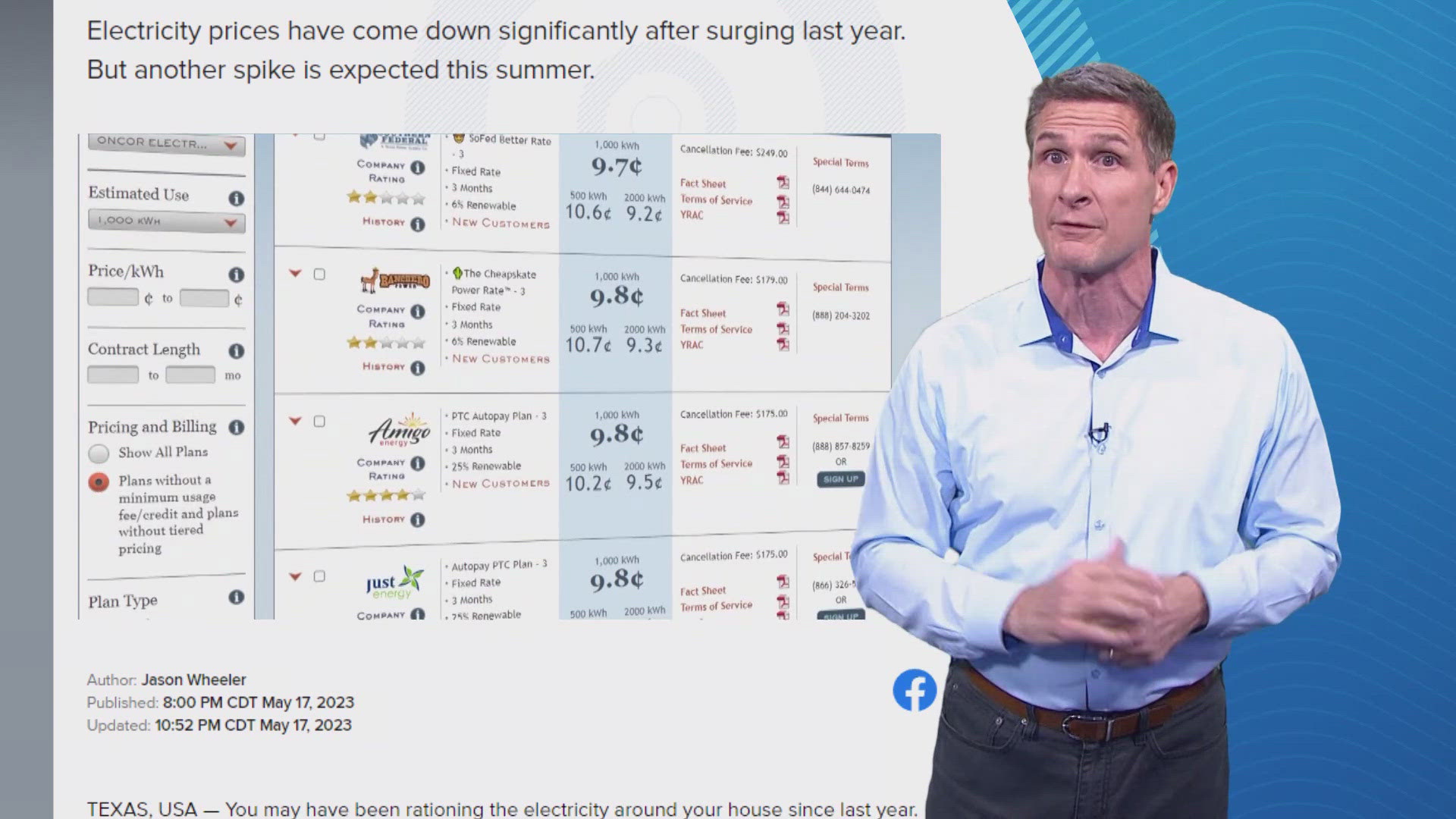DALLAS — A viewer just reached out to WFAA wondering why the electric bill for her thousand-square-foot apartment has been $300 a month for several months.
I asked her what her electricity rate was. She didn’t know, so she checked her expired service contract and discovered her rate had ballooned to 24 cents per kilowatt hour.
The woman explained that her lower-rate electricity contract expired, she forgot about it and stayed with her provider, but didn’t check the “special” month-to-month rate of 24 cents/kWh. Providers know we’re on the treadmill that is life, and that even if we intend to shop for a new electric plan, it can just get lost in the avalanche of items on our to-do lists.
Above the entry to shop for an electric plan, your to-do list should include always knowing what your electricity rate is and reminders to yourself when your current electric plan comes to an end.
The woman who reached out says her lower rate plan had expired about 11 months ago. I searched her zip code at the official Texas marketplace - powertochoose.org - and found plans for almost half what she had been paying for almost a year. She threw away a lot of money. But she just switched to one of those lower-rate plans.
You can find cheaper plans that are shorter than 12 months, but just for easy comparison, I looked at rates for 12-month contract plans in many zip codes and found about 12.4 cents/kWh in Houston and 12.7 cents/kWh in Dallas.
Although it is hard to compare because of differences in the ways charges are broken down, that is roughly similar (considering a 1,000 kWh usage) to rates at the larger city-run utilities in Texas where consumers can’t shop around for providers: In Austin (about 13.1 cents/kWh) and in San Antonio (about 12.8 cents/kWh).
Just before last summer, I reported that ‘Now may be the time to shop for electricity’. It turns out that those rates would have saved many of you substantially. They were the lowest I have seen in several years of spot-checking. But the rates I just found are lower than what I saw earlier this summer.
When to shop for electricity?
Remember, generally, market watchers say the best time to shop is in the shoulder seasons of Spring and Fall. But what if you still have a few months left on your current contract and you see a great deal now that you think you won’t be able to beat later?
Remember the timing trick I have used that I explained last year:
Once you land on a lower-rate plan, consider locking in the rate by delaying the start date of the new plan.
Comparepower.com noted, “Customers that use our service frequently take advantage of scheduling service in advance to lock in a favorable rate before their current plan expires. Most providers offer the option to sign up at a preferred rate and schedule service to begin in 30, 60, or 90 days, but this may vary by provider.”
Electrictyplans.com recommends Texans start browsing for electricity plans, “60 days before their contract expiration. That’s especially true for those who expire in the summer. When enrolling, just pick a “self-selected switch date. Have your new plan start on the expiration date of your current plan.”
Chillin' (and spendin') in that A/C!
Now, let’s talk again about the 24 cents per kWh woman: It wasn’t just her rate.
She explained that she uses a lot of air conditioning. Just understand that as you chill inside, the Energy Information Administration estimates air conditioning accounts for 19% of the electricity used in the U.S.
You won’t be surprised to know that here in Texas our number is higher: The EIA figures that air conditioning accounts for 28% of our electricity consumption in Texas!
In total, the agency also determined that, in total, we use more electricity than any other state to power our A/C needs 132.2 trillion Btu.
In fact, Texans consume almost as much electricity for air conditioning as we use to power our water heaters, TVs, lights and refrigerators combined. So, we have some room for improvement.
Trane, which makes a lot of A/C units, put together some figures on a few efficiency ideas. They estimate if you set the thermostat 7 to 10 degrees higher when you are away, you could save up to 10% on electricity costs.
Trane also confirms info that could intensify the battle over the thermostat settings in many households—that you can realize up to a 3% savings in electricity costs for each degree you nudge your thermostat higher than 72. Good luck!

